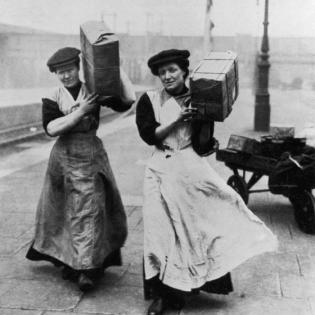Industrial Revolution and Women
This lesson gives an overview of the nineteenth century Industrial Revolution, and the major changes to how people live and work. Young people learn about the key inventions and changes that shifted focus from people and their skills to big machines and systems of mass production. The systems improved life in some ways and also decreased safety and personal power of workers. This sets the stage for the following lessons that focus on people who fought for the rights of people.
The learner will:
- describe how the Industrial Revolution changed the work experience.
- evaluate the impact of the Industrial Revolution on women and families.
- copies of Early Farm Life (handout)
- copies of Inventors and Their Inventions (handout)
- Optional: needle, thread, and fabric
- Eli Whitney Museum and Workshop https://www.eliwhitney.org/
- Lowe National Historical Park https://www.nps.gov/lowe/index.htm
Instructions
Anticipatory Set:
Introduce the Industrial Revolution as time in our history when we made a giant leap from handmade crafts to machine-made industries. This "Industrial Revolution" page from the Britannica website has a video with a simple, brief overview of the Industrial Revolution. The major changes were in using machinery for farm work and making textiles, working with steel, new kinds of transportation, and the automation of factory work.
As an example, discuss and compare working with needle and thread vs beginning with machine-made fabric. Compare the crafts of sewing and knitting with machine-made materials and automated production. What impact do you think that would have on families and women whose daily handiwork was replaced by a machine.
Read the excerpt Early Farm Life (handout) from one farmer's recall of life on the farm. Discuss the life of people on farms prior to the Industrial Revolution, noting those items that have changed in modern times.
Discuss how the factory system shifted the expectation that machines did the work previously done by humans. Low wages were paid to workers (including women and children seven or older). No longer did homemakers have to produce everything needed at home but could buy goods if they had the money.
What advantages and disadvantages do you think are in the production of products in a factory setting as opposed to the home?
Read about and discuss the following inventions and their inventors:
- Eli Whitney — the cotton gin and the musket
- Robert Fulton — the steam engine
- Francis Cabot Lowell — textile production.
The handout Inventors and Their Inventions may be used as background information.
Discuss how these inventions changed life at home.
During the Industrial Revolution, it became difficult for farmers to make a living, and they left home and moved to the city to find work. The Industrial Revolution changed the role of many women. Some had to work up to 16 hours a day at jobs for low wages and then go home to care for the family. Conveniences we have now did not exist at that time, so their lives were extremely hard and expectations were very high for their time and energy.
At this time, women did not have general rights. They either belonged to their husband or, if not married, to their father. They could not vote and could not be heard if they went to political assemblies. Discuss how it would have felt to live in that time as a woman. Discuss how women's rights are different now.
The following lessons introduce some of the women who helped to change the role of women in society.
Philanthropy Framework
-
Strand PHIL.I Definitions of Philanthropy
-
Standard DP 06. Role of Family in Philanthropy
-
Benchmark MS.3 Discuss the variety of family relationships in the nation's society.
-
-
